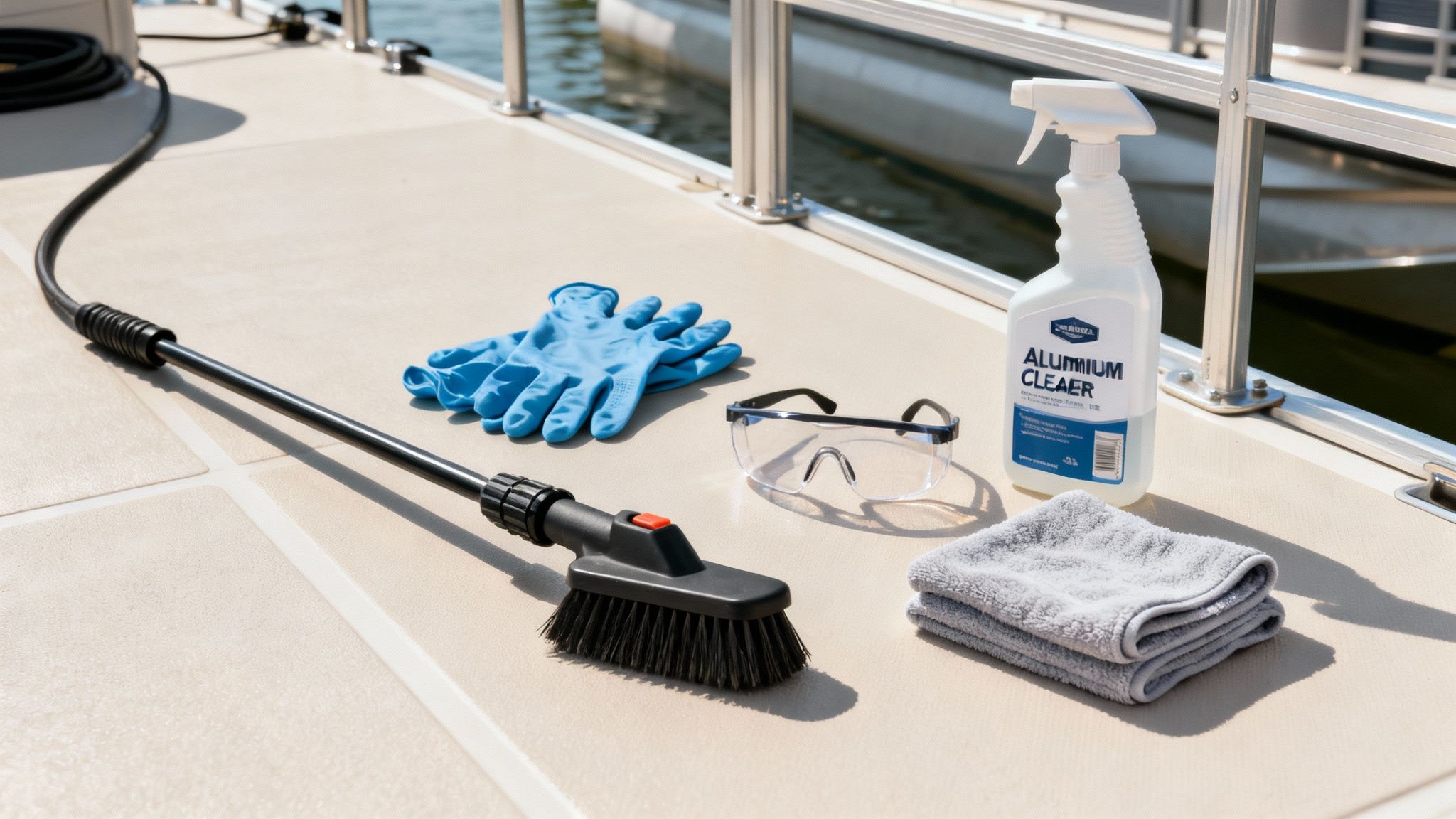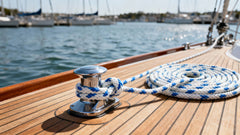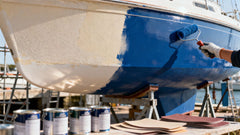How to Clean Aluminum Pontoons for a Lasting Shine
Staring at dull, chalky pontoons can be a real bummer. Over time, that constant exposure to water creates a stubborn layer of oxidation, scum, and waterline stains that regular soap and water just won't touch. If you want to restore that original factory finish, you'll need a proven process that goes way beyond a simple surface-level rinse.
Bringing Back the Showroom Shine to Your Pontoons
This isn't just about a one-time fix. Think of this as a maintenance strategy that keeps your boat looking its best and protects your investment season after season. A well-maintained boat isn't just about looks; it's about preserving its value.

We're going to break down the essential stages for transforming your pontoons, from the initial prep and deep cleaning all the way to the crucial final step of applying a protectant. You can find even more advice in our complete guide on how to detail a boat from top to bottom.
To give you a bird's-eye view, here's a quick rundown of the game plan.
Quick Guide to Pontoon Cleaning
Here's a quick overview of the essential stages for cleaning aluminum pontoons, what each stage accomplishes, and the key product for the job.
| Stage | Primary Goal | Recommended Product |
|---|---|---|
| Preparation | Get the boat ready for a deep clean. | A safe, dry workspace. |
| Deep Cleaning | Chemically dissolve years of buildup. | Aluminum Cleaner |
| Rinsing | Remove all cleaning agents to prevent streaking. | Pressure washer or strong hose. |
| Protection | Seal the aluminum against future damage. | Marine Polish |
This table maps out the journey from dull and stained to bright and protected. Each step builds on the last, leading to that incredible showroom finish.
Why You Can't Just Use Soap and Water
The main enemy here is oxidation. It's a chemical reaction between the aluminum, air, and water that forms that ugly, dull, chalky layer on the surface. This isn't your average dirt, so standard marine soaps won't cut it.
You need a specialized aluminum cleaner designed to break down that oxidation chemically. The process is straightforward: you spray the cleaner onto the pontoons, let it sit for about 5 to 10 minutes, and then scrub with a soft-bristle brush to lift all that gunk away.
The secret to a lasting shine isn’t just cleaning—it’s protecting. Applying a marine-grade polish after cleaning creates a barrier that slows down future oxidation, making each subsequent cleaning job significantly easier.
So, it's about more than just elbow grease. The key stages we'll walk through are:
- Preparation: Getting your boat out of the water and ready for a deep clean.
- Deep Cleaning: Using the right products to chemically dissolve years of buildup.
- Rinsing: Thoroughly removing all cleaning agents to prevent streaking.
- Protection: Applying a final sealant or polish to guard against future damage.
Assembling Your Pontoon Cleaning Toolkit
Walking into this project with the right gear is half the battle. Seriously. Having everything you need laid out and ready to go not only makes cleaning your aluminum pontoons a whole lot easier, but it also means you’ll get a far better result without accidentally damaging anything. The goal here is to work smarter, not harder.

Before you even think about spraying anything, get all your supplies together. A pressure washer on a low-to-medium setting is your best friend for that first rinse, blasting away the loose algae, lake scum, and grime. Just be sure to use a wide fan tip—a narrow, high-pressure stream can actually etch the soft aluminum.
Essential Cleaning and Safety Gear
The right tools are critical, both for getting the job done and for keeping yourself safe. When you’re dealing with cleaners strong enough to eat through years of oxidation, you have to put your own protection first. On the flip side, using the wrong brush can leave you with permanent scratches all over your 'toons.
Here’s a quick checklist of what you'll absolutely need:
- Personal Protective Equipment (PPE): This isn't optional. Always wear chemical-resistant gloves and a good pair of safety glasses. Cleaners that dissolve marine buildup can be really harsh on your skin and eyes.
- Specialized Aluminum Cleaner: You'll need a product like our Better Boat Aluminum Cleaner. It’s specifically formulated to cut through the chalky oxidation and stubborn marine stains that regular soap just laughs at.
- Soft-Bristle Boat Brush: A non-scratch boat scrub brush is non-negotiable. The soft bristles are key for working the cleaner into every nook and cranny without scratching up the aluminum surface.
- Microfiber Cloths: Grab a good stack of quality microfiber cloths. You’ll need them for applying the polish and buffing the pontoons to a brilliant, streak-free shine in the final steps.
For a deeper dive into everything you might need, check out our complete guide on building the perfect boat cleaning kit.
Take it from me: get everything ready before you start. Once you apply that cleaner, the clock is ticking. You really don’t want to be scrambling to find a brush while the cleaning solution is already starting to dry on the surface.
With this toolkit ready to go, you're all set for a successful cleaning day. Each piece of gear has a specific job to do in bringing back your pontoon's original luster safely and efficiently.
Deep Cleaning to Remove Oxidation and Grime
Alright, this is where the magic happens. Now that your pontoons are prepped and you’ve got your gear lined up, it's time to chemically break down years of oxidation, waterline stains, and that stubborn grime a simple rinse just won't touch. Using the right product and technique here is the secret to getting that head-turning, professional finish.

The key is a cleaner engineered specifically for this tough job. Our Better Boat Aluminum Cleaner is formulated to melt away that chalky, white buildup that makes pontoons look old and tired. When you apply it correctly, it does all the heavy lifting for you, bringing back the metal’s original brightness.
Applying Your Aluminum Cleaner for Best Results
Believe it or not, timing and temperature play a huge role in how well your cleaner works. You'll want to tackle this on a cool, overcast day or find a shady spot. If you try applying cleaner to sun-baked, hot aluminum, it'll just evaporate too fast, leaving you with streaks and an uneven mess.
Work in small, manageable sections—think four to five feet at a time. This keeps you in control and ensures you can rinse the cleaner off before it has a chance to dry on you.
- Spray Evenly: Lay down a liberal, even coat of the aluminum cleaner on one section. Don't be shy with it.
- Watch for Foam: You’ll know it’s working when it starts to foam up. That’s the chemical reaction breaking down the oxidation and grime right before your eyes.
- Let It Dwell (But Not for Long): Give the solution just a few minutes to work its magic—whatever the product label says, don't go over it. The goal is to let it dissolve the gunk without letting it dry.
When you're dealing with stubborn mineral deposits, it helps to understand the chemistry. Learning about effective methods for removing hard water spots on other surfaces can give you some good insights, as the principle of dissolving mineral buildup is the same. You can also get more targeted advice on our blog about choosing the right boat oxidation remover for your specific situation.
Tackling Tough Areas and Rinsing Thoroughly
Some spots are always going to be tougher than others. Think weld seams, the undersides of the pontoons, and that notorious waterline stain. These areas have a heavier buildup and will probably need a little more elbow grease. After letting the cleaner sit, grab your soft-bristle brush and gently agitate the surface. This helps lift the grime that the cleaner has already loosened.
Once you’ve worked a section, rinse it completely with your pressure washer or a strong jet from your hose. Always start rinsing from the top and work your way down. This guarantees all the cleaner residue is washed away and prevents it from streaking the areas you’ve just cleaned. Then, and only then, do you move on to the next section.
The most critical rule is simple: never let the cleaner dry on the aluminum. If you see a section starting to dry out, give it a quick mist of water to keep it wet, or just rinse it off and reapply if you have to.
Gentle Cleaning Solutions for Regular Upkeep
While a heavy-duty aluminum cleaner is a lifesaver for tackling years of baked-on grime, you don’t always need to bring out the big guns. Sometimes, a simpler approach is all you need.
For frequent maintenance, especially after a run in saltwater, a homemade solution can work wonders. This gentler method is perfect for light stains and regular upkeep between those deep-cleaning sessions. A basic mix of white vinegar and water is an eco-friendly way to neutralize corrosive salt deposits and handle minor oxidation without resorting to harsh chemicals.
Your Go-To Vinegar Solution
The most tried-and-true ratio is a straightforward 50/50 mix of white vinegar and plain water. Just grab a spray bottle, mix it up, and you’re ready to go. This simple concoction is incredibly handy for routine wipe-downs.
Here's how I like to do it:
- Spray the mixture generously onto a small, manageable section of the pontoon.
- Give it a gentle scrub with a soft cloth or a very soft-bristled brush. You're just trying to lift the surface grime, not scour the metal.
- Rinse the area thoroughly with fresh water right away. It's important to rinse before the solution dries and before you move on to the next section.
Believe it or not, plain old white vinegar is a fantastic cleaning agent for aluminum. The acetic acid, typically around 5-8%, is just strong enough to break down scum and waterline stains without harming the aluminum itself. It works by dissolving that chalky oxidation layer, helping to bring back the shine.
If you’re interested in other non-toxic cleaning agents, understanding how to combine things like DIY cleaning solutions with baking soda and vinegar can be a game-changer for all sorts of projects.
Just remember, this is a maintenance tool. It's not going to cut through thick, long-term buildup the way a specialized pontoon cleaner will. Think of it as part of a complete care routine that helps keep your pontoons looking great and extends the time between those major deep cleans.
How to Polish and Protect Your Cleaned Pontoons
Getting your pontoons clean is a huge win, but all that hard work will fade quickly if you don't protect the newly exposed aluminum. After cleaning and letting the surface dry completely, the final and most critical step is to apply a high-quality protective coating. This barrier is what really makes the shine last and dramatically slows down future oxidation.

Think of this final step as creating a shield against both oxygen and water—the two main culprits behind that chalky buildup. Using a marine-grade polish or sealant isn't just for looks; it's a vital part of pontoon maintenance that makes every future cleaning job that much easier.
Applying Polish for a Mirror-Like Finish
Achieving that brilliant, almost-blinding finish is easier than you might think. With the right product and a little technique, you can seal in that shine for the whole season. This isn't just about rubbing some wax on; it’s about creating a uniform, durable layer of protection.
We recommend our Better Boat Marine Polish with Wax for this job. Its formula is specifically designed to polish aluminum to a high gloss and leave behind a protective carnauba wax coating all in one go.
- Apply with a Microfiber Cloth: Put a small amount of polish onto a clean, soft microfiber cloth. Try not to apply it directly to the pontoon, as this can lead to uneven patches and wasted product.
- Work in Circular Motions: Tackle one small section at a time using even, overlapping circular motions. This is the key to getting consistent coverage without missing any spots.
- Buff to a Shine: Let the polish dry to a haze, which usually takes just a few minutes. Then, grab a separate clean, dry microfiber cloth and buff it off to reveal a streak-free, brilliant shine.
The real benefit of polishing is what it does for you long-term. By creating a slick, sealed surface, you prevent algae, scum, and waterline stains from getting a solid grip. Your next cleanup becomes a simple wipe-down instead of a major scrub session.
For a more detailed walkthrough, check out our guide on how to properly polish an aluminum boat. Honestly, this final step is your best defense against the elements and the secret to keeping that showroom look.
Your Top Pontoon Cleaning Questions, Answered
Even when you've got the process down, a few questions always pop up. It happens to all of us. Let's tackle some of the most common ones I hear from fellow boaters to make sure you get the best possible finish.
How Often Should I Really Clean My Pontoons?
The short answer? More often than you think, but it pays off big time. Being consistent is what makes this job manageable instead of a massive, weekend-long chore.
Plan on a deep, thorough clean with a dedicated aluminum cleaner at least once a year. The best times are either right before you launch for the season or as a key step in your winterizing checklist.
If your boat lives in saltwater, rinsing it with fresh water after every single trip is a must-do. It's the single best thing you can do to stop corrosion in its tracks. For a quick touch-up and to keep the shine alive, a light wash-down with a simple vinegar solution every couple of months works wonders.
Is It Okay to Use a Pressure Washer?
Absolutely, and it's a huge time-saver—if you use it right. Using the wrong setting or nozzle can do more harm than good on soft aluminum.
Grab a wide-angle nozzle for your pressure washer; a 40-degree tip is your best friend here. Keep the pressure on a low-to-medium setting. You just want enough force to blast away the loose grime and leftover cleaner, not to etch the metal. Never, ever use a pinpoint, high-pressure stream. You'll risk denting or scarring the surface permanently.
A crucial point many folks miss is that a cleaner and a polish are two totally different products with two totally different jobs. You can't just pick one.
An aluminum cleaner is the heavy lifter. Its whole purpose is to chemically strip away that chalky, dull layer of oxidation, algae stains, and all the gunk that builds up. A polish, on the other hand, comes after the cleaning. It's what brings back that mirror-like shine and, more importantly, lays down a protective layer to fight off future damage. You always clean first, then polish.
Ready to get that showroom shine? The Better Boat Aluminum Cleaner is engineered to dissolve years of oxidation and marine buildup, doing the hard work for you.




